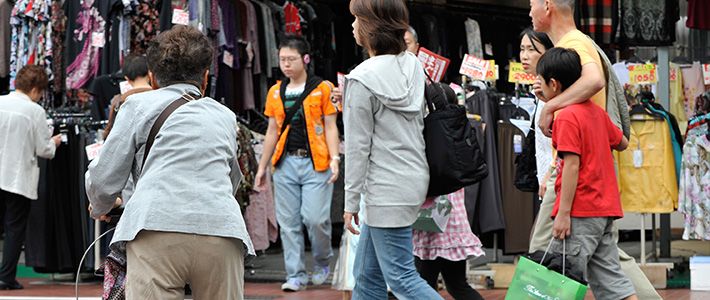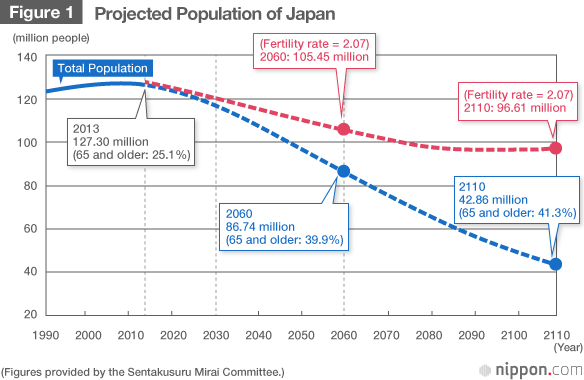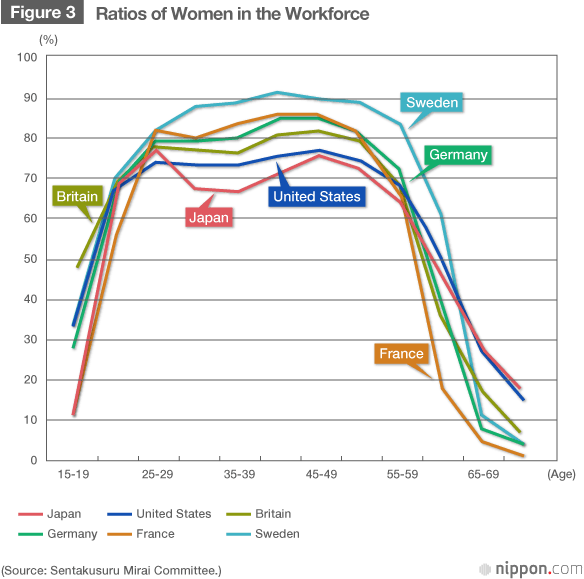
Fighting Population Decline, Japan Aims to Stay at 100 Million
Society Lifestyle- English
- 日本語
- 简体字
- 繁體字
- Français
- Español
- العربية
- Русский
A Hyper-Aged Society Unavoidable
In May, a panel appointed under the cabinet’s Council on Economic and Fiscal Policy released an interim report showing how Japan’s population will continue its downward trend over the next 50 years. The report—released by the Sentakusuru Mirai, or “deciding the future,” panel, chaired by Japan Chamber of Commerce and Industry head Mimura Akio—warns that at the current birthrate, Japan’s population will fall by a third over the next 50 years to 87 million. The country faces the prospect of becoming a hyper-aged society on a scale never before seen, with roughly 40% of citizens aged 65 and older.

The report estimates that even if Japan’s fertility rate, or the average number of children a woman bears, were to make a rapid recovery and stabilize at 2.07 by the year 2030 (the red line in figure 1), the population would still decline to around 100 million in the next three decades; it would wane further over the coming years until leveling out in the mid-2090s.
The effects of population decline will also be felt in the labor force—the total number of eligible workers aged 15 and older—where failure to increase the involvement of women and senior citizens in the job market will result in a worst-case scenario where the workforce, which measured 65.77 million in 2013, drops 42% by 2060 to 37.95 million. According to the report, this decline could be halted at 55 million over the same period if Japan’s fertility rate rises to 2.07 by 2030, the ratio of women in the workforce is boosted to a level similar to Sweden, and senior citizens are able to work five years beyond the current retirement age of 60.
Japan’s Looming Demographic Burden
It is unlikely that the Japanese economy will be able to maintain positive growth if the labor force continues a rapid decline and the country fails to boost productivity. A shrinking Japanese economy would become more susceptible to pressures from foreign financial markets and increasingly incapable of curtailing the effects of short-term market fluctuations.
Economic growth will also be weighed down by the demographic burden of a declining number of workers supporting an increasing number of retirees and other social welfare recipients. Rapid population decline will also shrink domestic markets, making them less attractive to potential investors and hindering innovation by reducing opportunities to share ideas. Once the economy begins to contract, it could potentially trigger further reduction in a downward growth spiral.
The demographic reality for rural areas is even direr. The current influx of people to metropolitan areas means that in comparison to 2010, 896 municipalities, equal to roughly 50% of the national total, will see their population of women aged 20–39 fall by more than half by 2040; 523 municipalities, or some 29% of the total, will see their overall population dwindle to under 10,000, a level at which fears rise that they could potentially cease to exist. The trend in Tokyo and surrounding metropolitan areas will be toward a graying of the population, with senior citizens making up an increasing ratio of residents.
These figures provide an unembellished portrait of the demographic crisis bearing down on Japan and draw attention to the necessity of stopping the decline in and graying of the country’s population.
More Resources for Children
The report calls for systematic changes, as well as the rapid overhaul of government programs and efforts to boost public awareness. The only way to change the future of Japan, it states, is to “ensure a prosperous environment for the young and consecutive generations so they can marry and raise children.” To accomplish this, the panel stresses the goal of maintaining the population at around 100 million over the next 50 years.
At a press conference, panel chair Mimura stressed the need to apply more resources toward raising the birthrate: “Compared to other countries, Japan’s social welfare system is skewed heavily toward the elderly, and more resources need to be directed toward the young. I would like to see priority placed on policies like increasing the retirement age to 70. We must streamline efforts directed toward senior citizens so that more emphasis can be placed on dealing with the low birthrate.”
Figure 2 Factors Affecting Birthrates
| Japan | France | Sweden | United States | |
|---|---|---|---|---|
| Average age women first marry | 29.2 (2012) | 30.8 (2011) | 33.0 (2011) | 25.8 (2006–2010 avg.) |
| Average mother’s age at first childbirth | 30.3 (2012) | 28.6 (2006) | 29.0 (2011) | 25.1 (2005) |
| Children born out of wedlock (2008) | 2.1% | 52.6% | 54.7% | 40.6% |
| Employees working over 49 hours/week (2012) | Average 22.7% Men 31.6% Women 10.6% | Average 11.6% Men 16.1% Women 6.5% | Average 7.6% Men 10.7% Women 4.2% | Average 16.4% Men 21.8% Women 10.2% |
| Hours/day husband spends on housework, childrearing (2006) | 1:00 | 2:30 | 3:21 | 3:13 |
Source: Sentakusuru Mirai Committee.
The report emphasizes advancing Abenomics policies to bring Japan out of its long economic stagnation and set it quickly on the road to long-term growth as the first step towards changing the country’s path. The panel has set 2020, when Tokyo will host the Olympic and Paralympic Games, as the year Japan’s trend toward low fertility and a graying society must be halted, noting that the latter half of the decade until them will see the country’s post–World War II baby-boomers turn 75, the ratio of senior citizens exceed 30%, and population decline begin in earnest.
Five Areas to Focus Reform Efforts
The report highlighted five areas where reform efforts need to be directed.
1. Create an environment conducive to raising children.
Ideally, the average number of children per couple should be 2.4, but currently this stands at 1.7.(*1) Policies to create an environment favorable to raising children, such as gradated increases in birth, child-rearing, and education subsidies for couples with three or more children, should be advanced to bring the fertility rate back up to the 2.0 range. These subsidy increases should rely on the current generation of taxpayers instead of passing the cost on to later generations. Programs to support birth and child rearing should be broadened with the view of supporting all aspects of raising children, so-called policies for children, and should be given top priority as investments in the future of Japan.
2. Ensure long-term growth by opening the economy and creating new value through innovation.
Keeping economic growth and development steady at current levels is paramount to maintaining the country’s quality of life. Advancing open and flexible institutional reforms will reinvigorate industry and corporations, while removing domestic barriers will allow Japan to enjoy the fruits of global growth and development by building a reservoir of human, material, monetary, and information resources. The strategic inclusion of foreign workers, including those with high-level skills, must be carried out with a wider national dialogue on how best to help them integrate into the economy and wider society.
3. Structure society so all people can reach their potential, regardless of age or gender.
Addressing the working styles of men and women in order to create an environment where couples can balance the demands of work and child rearing will help correct the decline in the workforce ratio of women in their twenties and thirties, as is seen in the M-curve in figure 3. Allowing older people to work until 70 will redefine the role senior citizens play in society, enabling them to remain as active and productive parts of the labor force.

4. Strategic promotion of regional strengths
Implementing new uses of regional resources, such as agriculture and tourism, will create local employment hubs. Regional urban centers need to be the focus of concentrated government service programs and efforts to revitalize economic activity. The continued exodus of rural populations to Tokyo can be brought under control by highly competitive corporations establishing bases of operation in strategic regional cities.
5. Create a secure social base
Efforts must be made to create a specific Japanese brand through promoting the unique traditions and culture, as well as an aesthetic sense and values that are products of the country’s distinct historical landscape. Japan can remain an influential and active player on the international stage by contributing to global efforts and rule making.
(Banner photo © Jiji Photo)
(*1) ^ This figure is taken from the National Fertility Survey conducted by the National Institution of Population and Social Security Research and is current as of June 1, 2010. According to population statistics announced by the Ministry of Health, Labor, and Welfare, Japan’s total fertility rate for 2013 was 1.43.
population birthrate aging Fertility rate Society senior citizens